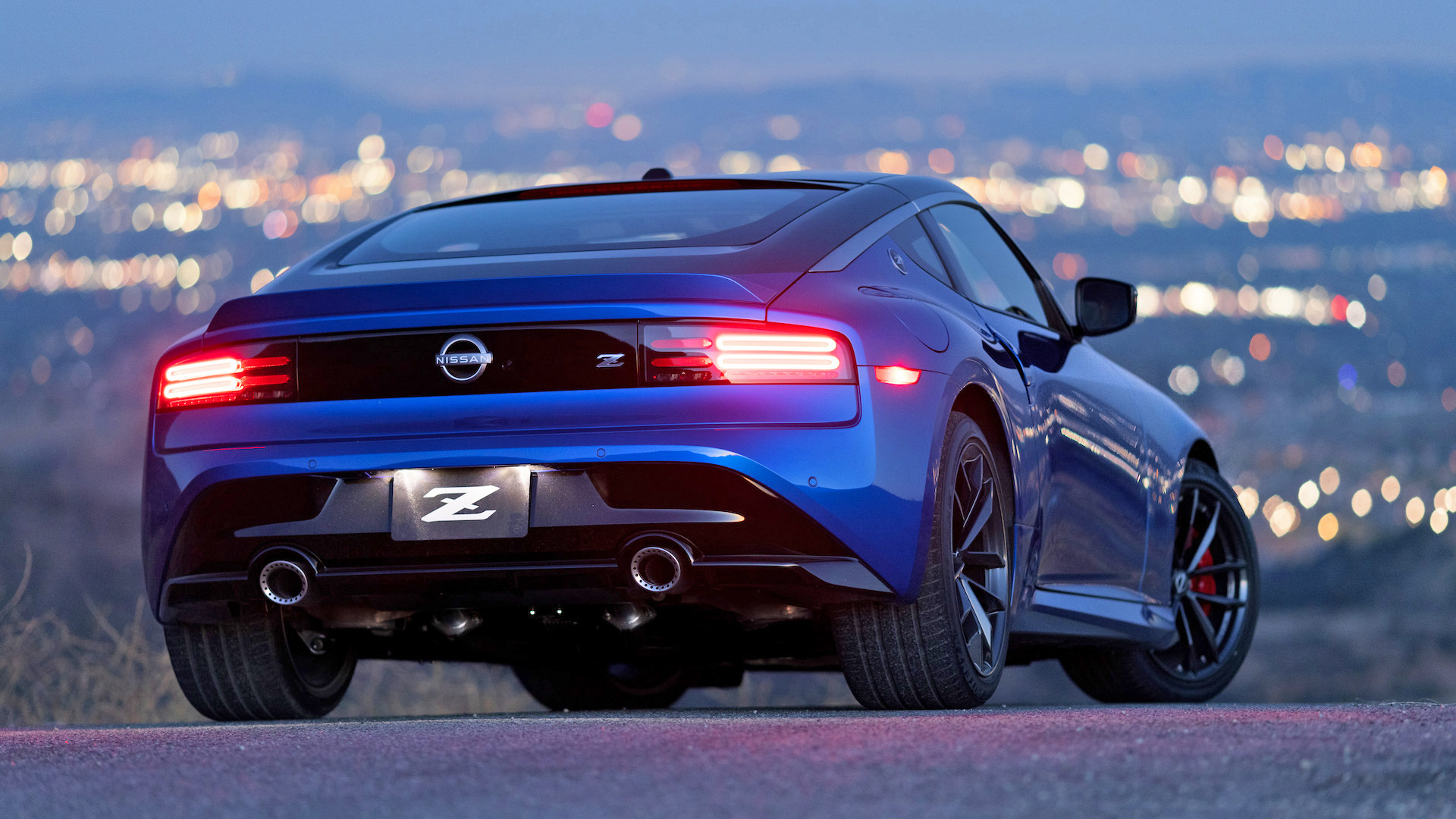

It’s here, folks. A whole 13 years after the 370Z first went into production, its successor is finally here. Say hello to the 2023 Nissan Z. Nope, not the 400Z, not the 390Z. Not even the 370Z 2.0. Just Z. Here are the headline facts and figures you need to know: It’s coming to U.S. dealers next spring which means, yes, it’s a 2023 model year car. It’ll make 400 horsepower from a 3.0-liter twin-turbo V6. And, judging by the excitement it’s generated within The Drive‘s Slack newsroom, it looks the business.
Yes, it has a manual. No, Nissan has not announced pricing just yet. But there’s still a lot to dig into.

Stunningly Familiar Style
This production-ready Z looks pretty much just like the Proto we first saw almost an entire year ago. 240ZG-inspired headlights? Check. Original Z-honoring profile? Check. 300ZX rear end? Checkarooni. Nissan even managed to get the prototype’s niftily flush door handles onto the showroom spec.
The inside should also look familiar to those already acquainted with the Proto. The Z-car’s signature trio of analog center gauges remains and now sits above a touchscreen running Apple CarPlay and Android Auto. As standard, this screen measures eight inches while the upmarket Performance model rocks a nine-inch unit with eight-speaker Bose audio and active noise cancellation. A 12.3-inch digital instrument cluster is standard and features three display modes as well as a tach with a redline deliberately positioned at 12 o’clock.










A Quicker Z
Just as the rumors predicted, the seventh-gen Z-car is powered by Nissan’s 3.0-liter VR30DDTT twin-turbo V6 producing 400 hp and 350 pound-feet of torque. In the 2023 Z, this engine makes peak power at 6,400 rpm, peak torque from 1,600 to 5,600 rpm, and revs to 6,800. Small-diameter turbos and an electronic variable valve timing intake system are said to contribute to better response and fuel efficiency.
And here, you don’t have to imagine how it makes the car move. Take a look:
Transmission choices include an optional nine-speed automatic with aluminum paddle shifters or the standard six-speed, close-ratio manual. The latter is accompanied by a high-performance Exedy clutch, a carbon fiber composite driveshaft, and, on the higher Performance trim, rev-matching—a technology first pioneered by this car’s predecessor and subsequently adopted by many other manual performance cars.
Nissan has not released an official time but is instead making us do math by saying it’s estimating a zero-to-60-mph time that’s 15 percent quicker than before. When Car and Driver tested a manual 2019 370Z, it hit 60 mph in five seconds flat, which should mean a 4.25-second sprint for the new three-pedaled Z.

The way the Z moves through corners is said to be improved as well with a claimed 13 percent increase in max cornering G thanks to a more rigid body, retuned suspension, retuned steering, and fatter front tires. Monotube shock absorbers at all four corners are new, as is the geometry for the aluminum double-wishbone front end. Meanwhile, the rear multi-link setup has also been rejigged.
Ventilated disk brakes all around are mounted behind 18-inch wheels wrapped in Yokohama Advan Sport tires on the entry-level Sport trim, while the Performance rides on super lightweight, 19-inch forged Rays wheels and Bridgestone Potenza S007s.



Put That Thing in Sport
There will be two drive modes on automatic Zs: standard and sport. Naturally, sport mode alters the steering and dynamic vehicle control system for more athletic driving and turns on the presumably speaker-based active sound enhancement because it just wouldn’t be a performance car in 2021 without some of that.
Manual Zs, however, do not appear to have any drive modes probably because Nissan has wisely assumed that anybody driving a manual Z is, mentally, always in sport mode.

One Z, Two Trims, and a Special Edition
As you might have already gathered, the 2023 Nissan Z will be available in two trims: the base Sport or the (probably) more expensive Performance, both of which can be had with either transmission choice. In addition to the aforementioned bigger wheels, tires, and manual rev-matching, the Performance Z also adds bigger brakes, launch control (a rear-drive Nissan first), a mechanical clutch-type limited-slip differential, sportier-tuned suspension, small spoilers on the front and rear (the one on the front was developed using know-how gained from GT-R development), heated mirrors, powered leather seats with different bolstering, a premium leather steering wheel, aluminum pedals, and, for those who opt for the nine-speed auto, the same shift paddles out of the GT-R.






For keen (and well-connected) Nissan fans, a Performance-based “Proto Spec” special edition will also be available. Limited to just 240 U.S.-bound units, this special Z lives up to its name by mimicking the bright yellow Z Proto, featuring yellow brake calipers, bronze wheels, a different manual shift knob, yellow-accented leather seats, and exclusive suede and yellow-stitched interior trim.




Official pricing has yet to be announced but the 2023 Nissan Z will hit U.S. dealers in spring of 2022. A previous rumor says Nissan’s gorgeous new coupe will start at under $35,000, undercutting the less powerful six-cylinder Toyota Supra by more than $15,000. Regardless of how much it ends up costing, however, the Z already has the Supra beat in one area particularly important to enthusiasts: authenticity. Unlike the BMW-based Supra, this Nissan-badged vehicle is actually a Nissan.
Oh, and did we mention this one comes with a manual? Because it comes with a manual.











Got a tip or question for the author about the new Nissan Z? You can reach them here: chris.tsui@thedrive.com